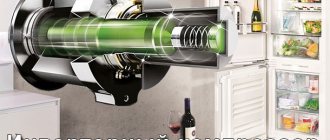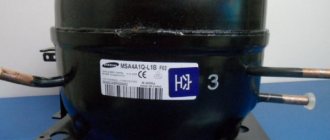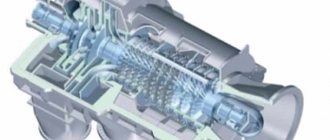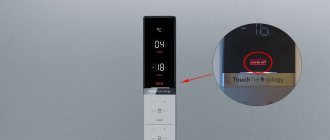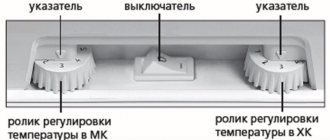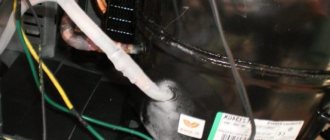Description of linear refrigerator compressor
When we close the refrigerator door, we hear a characteristic noise made by its operation.
When the compressor starts working, it creates a pressure difference inside the chambers. During operation, it cools the refrigerator compartments, removing heat by compressing and pumping the refrigerant. It transfers heat from the internal chambers to the outside, thereby cooling them. The linear type of equipment itself is a small device that operates using an internal piston driven by electricity. It is not big and takes up little space. The entire mechanism is well hidden under its box. The design provides special holes for fastening to the machine body.
Linear compressor in the refrigerator: what does it mean?
Linear type devices are installed on 8 out of 10 modern refrigerator models. The design of such a compressor includes a cylinder, an EM coil with winding, a spring and a piston. Like all other types of compressors, linear circulates coolant throughout the system.
It does not work continuously: it turns on only when the temperature in the chambers rises above the set one. This is why you can so often hear the refrigerator start to operate when opening the door or loading food.
Principle of operation
When electric current is applied to the winding of the coil, an electromagnetic field is created around the piston, causing the mechanism to move. The spring in the design is intended to return the piston to its original position. When the refrigerant is “driven” through the system, the supply of electricity to the coil is stopped, and the device shuts down until the next cycle.
Important! The compressor is turned on not at strictly defined intervals, but as needed, when the sensor installed in the chamber detects a temperature reading higher than the set one. The temperature sensor also works as long as the compressor is on.
The first models of such devices used a crank mechanism coupled with an electric motor. This design had a much larger number of friction points and was less reliable. In addition, during operation it produced much more noise. After “upgrading” and getting rid of these parts, the compressors became 15–20 dB less noisy.
What is a linear refrigerator compressor used for?
A linear compressor, as we noted earlier, creates a pressure difference inside the refrigerator. Depending on the type of equipment, they are divided into several groups:
- screw type;
- piston type;
- rotational;
- centrifugal;
- spiral type.
Each type of equipment has both positive and negative sides. But their purpose is one, to transfer heat from the internal chambers to the outside. It should be noted that heat transfer from the camera may differ depending on the type of camera. It's no secret that the temperature of the freezer is different from the storage chamber, therefore, heat transfer inside it is carried out more intensively.
Principle of operation
The compressor is the main part that makes the freezer and refrigerator compartments work; the operating principle of refrigerators is largely the same.
It creates a difference in pressure between individual parts of the refrigerator cooling system.
The unit compresses the refrigerant and pumps it through the heat exchange system, ensuring the operation of the refrigeration unit.
To understand what a linear compressor is, you need to know what types of these parts there are.
There are several different types of this part depending on the design: screw, spiral, rotary, centrifugal and piston type. Some of them are no longer in use; they have been replaced by linear and inverter compressors. They are simpler designs, the ability of which was created on the basis of modern advanced technologies.
The linear design can be called a middle ground between older installations and the latest inverter models, combining simplicity and performance.
It differs from them in quieter operation and more economical use.
The operating principle of a linear device is quite simple, and it is not difficult to explain how a linear compressor works.
A special sensor is installed that compares the temperature in the refrigerator with the one selected by the user. If the temperature is different, the compressor begins to lower it as quickly as possible. After reaching the indicator, it turns off, continuing the comparison, and, if necessary, turns on again.
View » What to do when the freezer temperature indicator blinks in a Bosch refrigerator
A feature of these types of devices is the absence of a motor and crankshaft. They are replaced by a coil with an electromagnetic rod connected to the pump piston.
When an alternating electric current flows through the winding of the coil, it creates a field that sets the rod with the piston in motion. There is a spring at the end of the rod; it returns the rod to its original position after compression. Then the process repeats again.
This process eliminates additional friction of parts due to the electromagnetic field and eliminates the noise of the refrigerator during startup.
How does a linear compressor work on a refrigerator?
We have looked at the operation of the linear model on surfaces, now we will consider in more detail the principle of operation depending on its type. Let's start in order:
- Screw type compressor , for this type of design a screw part is used, which ensures the circulation of refrigerant throughout the entire structure. During operation, the screw helps create high pressure inside the system.
- Electricity is supplied to a special rotor connected to the piston using a special connecting rod. The piston, in the process of translational movements, creates pressure inside the system, which allows for more efficient cooling of the system.
- For rotary type operation, a special rotor is used , which drives an electric motor. When the rotor begins to rotate, the eccentric flows to the inner surface of the cylinder. Where it compresses the refrigerant gas and pushes it out through the release valve.
- Centrifugal-type equipment is a system that operates on the principle of compressing a gaseous medium using a rotor with a shaft. The rotor has special wheels that are located symmetrically to each other. When the wheels with blades rotate, the gas begins to move from the center of the wheels to the edge. Then the gas is compressed, acquiring inertia, and begins further movement through the system. This process helps the refrigerator operate and maintain the optimal temperature.
- When operating spiral-type equipment , the refrigerant is compressed in the space between two spirals. One of them stands, moves forward, and the second rotates around it. It is important to note that the rotation has a non-standard trajectory; when the engine operates, which drives the movable spiral, it will mix along the walls of the first spiral, sliding along the oil film. The point of contact shifts from the edge of the spiral to the center, which facilitates the absorption of the substance. High gas pressure is achieved in the center of the equipment, and then the gas moves through the discharge line throughout the system.
Depending on its type, the principles of operation are slightly different, but despite this, all types of linear compressors are designed for one specific purpose, to regulate the pressure in the refrigerator chambers and maintain the temperature regime.
In addition to the linear type of compressor, there is also an inverter type, which is also very popular; below we will take a closer look at their differences.
Linear Compressor Parameters
For this device, the most important parameters are cooling capacity, developed power and operating pressure. On average, the latter indicator for most models fluctuates between 2–4 atmospheres. This pressure level is optimal for normal circulation of freon through the cooling system. Many manufacturers equip their equipment with special pressure regulators in order to keep it at the desired level and prevent rupture of the cooling system pipes.
If we talk about cooling capacity, then this indicator is inextricably linked with the power of the device and the brand of refrigerant that it uses. Cooling capacity is measured in kilocalories per hour, and for many refrigerators using freon with the R12 index (for example, some LG models), it ranges from 45 to 150 kcal/hour, depending on the electrical power of the device.
Reference. At one time, a linear compressor was considered quite energy-efficient, but today inverter-type devices clearly hold the palm in this unspoken competition. Since they operate without ever turning off (and it is at the moment of switching on that the engine of the refrigeration unit bears the most serious load), their service life is much longer, and energy consumption is lower. However, this positive point is easily offset by the cost of a refrigerator model with an inverter compressor.
In order to find out whether the compressor is working properly, repairmen use a multimeter. By connecting it between the coil winding and the housing, they measure the winding resistance. A larger deviation from the norm indicates damage to the winding, and a smaller deviation indicates a short circuit in the system. Since the winding may have different source material and structure, its normal resistance value may be different for each model.
Differences between linear and inverter refrigerator compressors
Unlike linear models, the inverter model does not heavily load the refrigerator systems; it does not need to be turned on to maintain the temperature regime and turned off every time, it simply works stably and smoothly.
This principle of operation loads the electrical network noticeably less and reduces the percentage of possible short circuits to a minimum. When you turn on the equipment, the inverter model quickly reaches the desired temperature and maintains it throughout the entire operating time. It practically does not turn off, but simply reduces the power of operation. It should be noted that power changes occur gradually and smoothly, without loading the system. As a result of such work, large fluctuations in the temperature of the chambers are not observed. Let's break down its advantages:
- due to the fact that there is no need to work at maximum power, the noise level becomes less;
- The service life of such a refrigerator is noticeably longer, due to the fact that there are no periodic switching cycles.
But, it would seem, why have refrigerators with an inverter system not yet squeezed out models with linear compressors? But not everything is so simple; these models also have weaknesses:
- the inverter model is more sensitive to voltage drops;
- the cost of such models is noticeably higher than that of refrigerators with linear compressors.
Advantages and disadvantages of linear compressors
Advantages of linear compressors in refrigeration applications:
- Minimum noise level, which is ensured by smooth start and stop of the compressor.
- Long service life thanks to a simple mechanism with few moving parts.
- Economical consumption of energy resources.
- Insensitivity of linear compressors to voltage changes.
- Minimum temperature deviations. The system monitors temperature deviations in the chamber from the set one.
- Long-term storage of food thanks to stable temperatures and rapid cooling.
- The market price of such refrigerators is lower in comparison with models equipped with other compressor systems.
The installation has several disadvantages : characteristic clicks when turning the device on and off; when starting, the compressor experiences maximum load.
Advantages of refrigerators with linear compressor
A refrigerator with linear equipment is more productive; its electromagnetic circuit can significantly reduce electricity losses during equipment operation.
Important! When operating this equipment, “direct current” circuits are used, which improves the energy saving class. This equipment has a quiet start system, which reduces the noise level and keeps it to a minimum. If we compare environmental indicators, this model is significantly ahead of the inverter model in many respects. And most importantly, its price is noticeably cheaper than its competitor, which is a strong argument in its favor.
Subscribe to our Social networks
